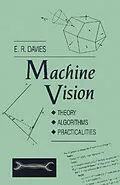Machine Vision: Theory, Algorithms, Practicalities covers the limitations, constraints, and tradeoffs of vision algorithms. This book is organized into four parts encompassing 21 chapters that tackle general topics, such as noise suppression, edge detection, principles of illumination, feature recognition, Bayes' theory, and Hough transforms.
Part 1 provides research ideas on imaging and image filtering operations, thresholding techniques, edge detection, and binary shape and boundary pattern analyses. Part 2 deals with the area of intermediate-level vision, the nature of the Hough transform, shape detection, and corner location. Part 3 demonstrates some of the practical applications of the basic work previously covered in the book. This part also discusses some of the principles underlying implementation, including on lighting and hardware systems. Part 4 highlights the limitations and constraints of vision algorithms and their corresponding solutions.
This book will prove useful to students with undergraduate course on vision for electronic engineering or computer science.
Autorentext
Roy Davies is Emeritus Professor of Machine Vision at Royal Holloway, University of London. He has worked on many aspects of vision, from feature detection to robust, real-time implementations of practical vision tasks. His interests include automated visual inspection, surveillance, vehicle guidance, crime detection and neural networks. He has published more than 200 papers, and three books. Machine Vision: Theory, Algorithms, Practicalities (1990) has been widely used internationally for more than 25 years, and is now out in this much enhanced fifth edition. Roy holds a DSc at the University of London, and has been awarded Distinguished Fellow of the British Machine Vision Association, and Fellow of the International Association of Pattern Recognition.
Inhalt
Preface
Acknowledgements
Glossary of Acronyms and Abbreviations
1 Vision, the Challenge
1.1 Introduction-Man and his Senses
1.2 The Nature of Vision
1.3 Automated Visual Inspection
1.4 What this Book is About
1.5 The Following Chapters
1.6 Bibliographical Notes
Part 1 Low-Level Processing
2 Images and Imaging Operations
2.1 Introduction
2.2 Image Processing Operations
2.3 Convolutions and Point Spread Functions
2.4 Sequential Versus Parallel Operations
2.5 Concluding Remarks
2.6 Bibliographical and Historical Notes
2.7 Problems
3 Basic Image Filtering Operations
3.1 Introduction
3.2 Noise Suppression by Gaussian Smoothing
3.3 Median Filtering
3.4 Mode Filtering
3.5 Bias Generated by Noise Suppression Filters
3.6 Reducing Computational Load
3.7 The Role of Filters in Industrial Applications of Vision
3.8 Sharp-Unsharp Masking
3.9 Concluding Remarks
3.10 Bibliographical and Historical Notes
3.11 Problems
4 Thresholding Techniques
4.1 Introduction
4.2 Region-Growing Methods
4.3 Thresholding
4.4 Adaptive Thresholding
4.5 Concluding Remarks
4.6 Bibliographical and Historical Notes
4.7 Problems
5 Locating Objects via Their Edges
5.1 Introduction
5.2 Basic Theory of Edge Detection
5.3 The Template Matching Approach
5.4 Theory of 3 x 3 Template Operators
5.5 Summary-Design Constraints and Conclusions
5.6 The Design of Differential Gradient Operators
5.7 The Concept of a Circular Operator
5.8 Detailed Implementation of Circular Operators
5.9 Structured Bands of Pixels in Neighbourhoods of Various Sizes
5.10 The Systematic Design of Differential Edge Operators
5.11 Problems with the Above Approach-Some Alternative Schemes
5.12 Concluding Remarks
5.13 Bibliographical and Historical Notes
5.14 Problems
6 Binary Shape Analysis
6.1 Introduction
6.2 Connectedness in Binary Images
6.3 Object Labelling and Counting
6.4 Metric Properties in Digital Images
6.5 Size Filtering
6.6 The Convex Hull and its Computation
6.7 Distance Functions and their Uses
6.8 Skeletons and Thinning
6.9 Some Simple Measures for Shape Recognition
6.10 Shape Description by Moments
6.11 Boundary Tracking Procedures
6.12 Concluding Remarks
6.13 Bibliographical and Historical Notes
6.14 Problems
7 Boundary Pattern Analysis
7.1 Introduction
7.2 Boundary Tracking Procedures
7.3 Template Matching-a Reminder
7.4 Centroidal Profiles
7.5 Problems with the Centroidal Profile Approach
7.6 The (s, ) Plot
7.7 Tackling the Problems of Occlusion
7.8 Chain Code
7.9 The (r,s) Plot
7.10 Accuracy of Boundary Length Measures
7.11 Concluding Remarks
7.12 Bibliographical and Historical Notes
7.13 Problems
Part 2 Intermediate-Level Processing
8 Line Detection
8.1 Introduction
8.2 Application of the Hough Transform to Line Detection
8.3 The Foot-of-Normal Method
8.4 Longitudinal Line Localization
8.5 Final Line Fitting
8.6 Concluding Remarks
8.7 Bibliographical and Historical Notes
8.8 Problem
9 Circle Detection
9.1 Introduction
9.2 Hough-Based Schemes for Circular Object Detection
9.3 The Problem of Unknown Circle Radius
9.4 The Problem of Accurate Centre Location
9.5 Overcoming the Speed Problem
9.6 Concluding Remarks
9.7 Bibliographical and Historical Notes
9.8 Problem
10 The Hough Transform and Its Nature
10.1 Introduction
10.2 The Generalized Hough Transform
10.3 Setting up the Generalized Hough Transform-Some Relevant Questions
10.4 Spatial Matched Filtering in Images
10.5 From Spatial Matched Filters to Generalized Hough Transforms
10.6 Gradient Weighting Versus Uniform Weighting
10.7 Summary
10.8 Applying the Generalized Hough Transform to Line Detection
10.9 An Instructive Example
10.10 Tradeoffs to Reduce Computational Load
10.11 The Effects of Occlusions for Objects with Straight Edges
10.12 Fast Implementations of the Hough Transform
10.13 The Approach of Gerig and Klein
10.14 Concluding Remarks
10.15 Bibliographical and Historical Notes
11 Ellipse Detection
11.1 Introduction
11.2 The Diameter Bisection Method
11.3 The Chord-Tangent Method
11.4 Finding the Remaining Ellipse Parameters
11.5 Reducing Computational Load for the Generalized Hough Transform Method
11.6 Comparing the Various Methods
11.7 Concluding Remarks
11.8 Bibliographical and Historical Notes
11.9 Problems
12 Polygon Detection
12.1 Introduction
12.2 The Generalized Hough Transform
12.3 Application to the Detection of Regular Polygons
12.4 The Case of …
